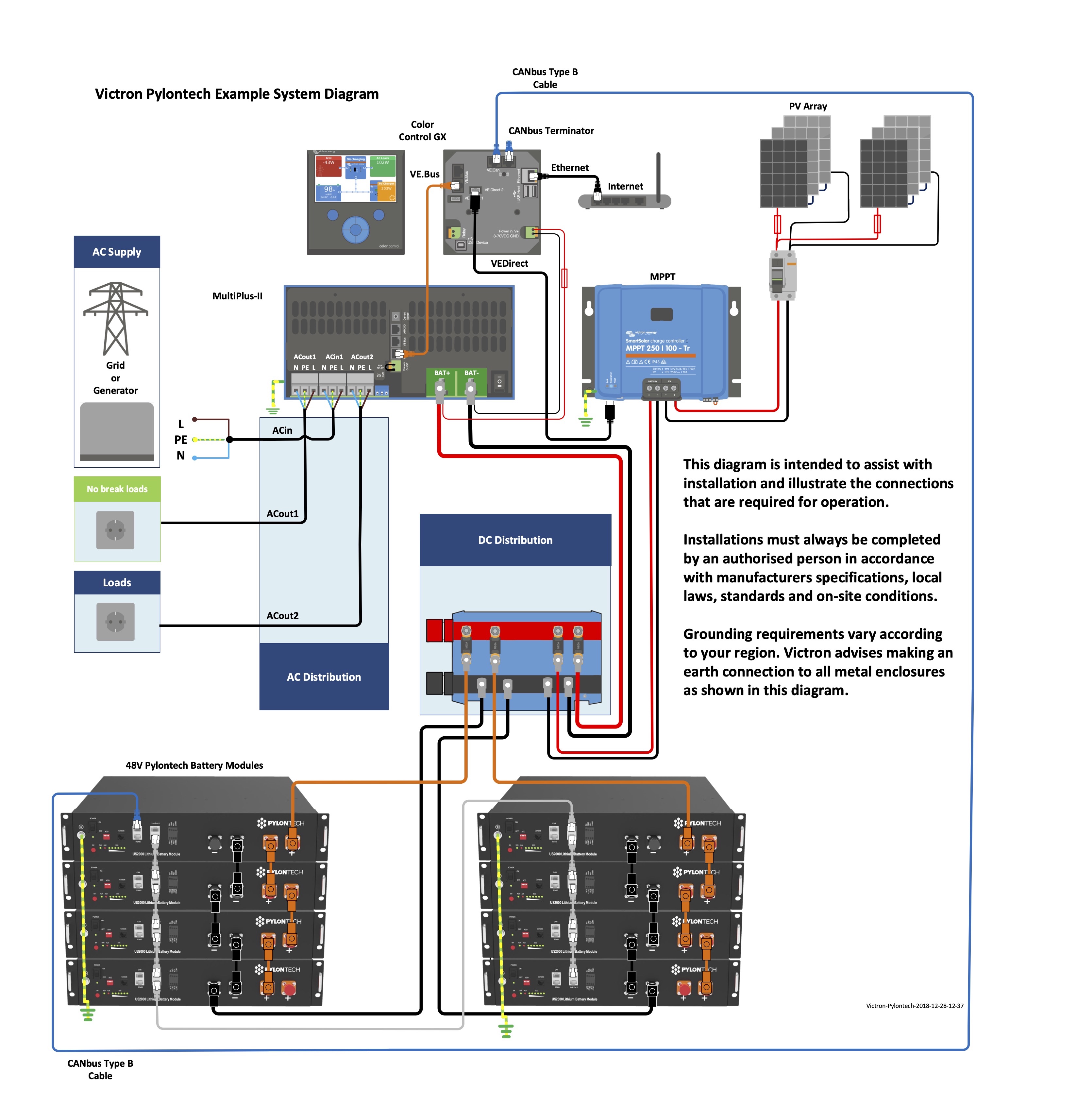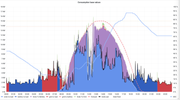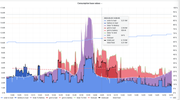Finally almost finished my project
Posted: Tue Mar 28, 2023 10:11 am
It's taken years to get to this point but I've finally almost finished my project. Thanks to Joe for putting me in touch with the installer up north or it would never have happened. There have been a lot of ups and downs with the remortgage taking too long and then the first installer leaving me in the lurch and then an accident on delivery. I've probably ended up a year behind schedule and lost a huge amount of potential savings as the money has been sitting in the bank doing nothing apart from accumulating interest.
I originally had 6.42kW of ground mount panels hooked up to a SolarEdge HD5000 and now have added a further 12kW of panels attached to two MPPT 450/100 trackers combined with 8 Pylontech US5000 (38.4 kWh). The additional inverter/charger is a Victron Quattro 10000. The batteries can be charged from empty to full in about 3 hours at full production with most of the charging happening quite efficiently using the DC generation. The setup is similar to this . It gives us islanding mode which is essential to allow us to run our water supply to water the animals. Carrying 100s of liters of water from a near by stream for 8 days last year was not fun.
. It gives us islanding mode which is essential to allow us to run our water supply to water the animals. Carrying 100s of liters of water from a near by stream for 8 days last year was not fun.
What I love about the Victron kit is how accessible it is. I am running a node-red instance on the cerboGX which is controlling the state of charge of the batteries and what the Quattro is doing depending on the forecast solar and heating load of the house. It aims to time shift the cheap rate electricity whilst making sure the batteries are empty to accept sunshine. I am downloading the predicted PV generation in 30 minute chunks from Solcast. The weather is downloaded from open weather map and that is used to forecast the heat pump heating demand. This is then used to predict the SOC down the line and make decisions based on that. I try to avoid using the battery in the cheap rate period if it will only have to be charged again in one of the future cheap rate periods.
I've also heavily modified the Victron ESS to make it a bit smarter. For instance when charging during the cheap periods using the built in schedule it will charge at 7700kW to hit the fixed SOC. This results in almost 15% of wasted energy. My code will target the minimum required SOC to get me through the next expensive period and then charge at the minimum rate to achieve that SOC during a cheap period. This can result in a 10% saving which certainly adds up over the year. There are numerous other small logic improvements which over 20 years will save £500 here and there
I've created a custom logging interface which is a hybrid of the SMA logging which I quite liked. It is all the charging/discharging/solar production and consumption+SOC data in one graph which works quite well. The node-red code does the necessary calculations to work out what is going where. This is logged in an influx DB. Grafana is then used to view the data. These are running in docker containers on a synology.
I've added a screen shot of yesterday where I was hoping to hit 100kWh for the first time this year. Some midday cloud spoilt that. I achieved Several saved up loads of washing, dishwasher, hoovering, House heating at -2->5ºC and 27kWh into the MG5, charging 450liters of hot water + charging the battery to get me through later in the day.

The second/thrid image show a bit of time shifting (battery charging is the salmon colour).I've zoomed into the afternoon in the third image. This shows how useful it can be seeing the electricity usage. The little spikes in the latter stage are not an artefact but a leak in the pipe near the poly tunnel. It is causing the water pump in the borehole to come on at regular intervals. You can also see the self use of the battery, charging the battery from solar and grid and grid use for the load from 13:30 when the cheap rate starts.


The final image shows what I try not to do which is export as I don't get paid for it. That's a battle for another day to get the SEG despite not having an MCS certificate. I do have one for the SolarEdge so maybe I can just apply on that. I also have no signal in the area for a smart meter so that is another hurdle to overcome.

There is daily logging of the money saved so I can see when I finally hit breakeven.(7 years ish). Deciding what is a saving is quite tricky. Previously we would try and do all washing/tumble drying etc in the cheap rate periods. But habits are already changing with the increased generation/timeshifting so savings are artificially boosted when I log use of the washing machine during an expensive period. I also have to download the myenergi history for the Zappie and Eddie to subtract them or it looks like a I am saving way more than I in fact am. We would never normally charge the car in the expensive period so I have to make sure that isn't being recorded as a £2.8/hr saving.

Going forward I am looking to have 'plug and forget' charging of the car. Unfortunately the Zappie is quite limiting in that I can't control it beyond full charge rate or 1.3kW. There is no way to ask it to charge at a set rate which does often make it tricky to fit in the solar curve. Having the batteries charge first and then the car using exported power results in extra energy sent to the grid as the car will only take 7kW leaving 7kW or so going to the grid. It's better to have the batteries and car charging concurrently to make better use of the generation.
I originally had 6.42kW of ground mount panels hooked up to a SolarEdge HD5000 and now have added a further 12kW of panels attached to two MPPT 450/100 trackers combined with 8 Pylontech US5000 (38.4 kWh). The additional inverter/charger is a Victron Quattro 10000. The batteries can be charged from empty to full in about 3 hours at full production with most of the charging happening quite efficiently using the DC generation. The setup is similar to this
 . It gives us islanding mode which is essential to allow us to run our water supply to water the animals. Carrying 100s of liters of water from a near by stream for 8 days last year was not fun.
. It gives us islanding mode which is essential to allow us to run our water supply to water the animals. Carrying 100s of liters of water from a near by stream for 8 days last year was not fun.What I love about the Victron kit is how accessible it is. I am running a node-red instance on the cerboGX which is controlling the state of charge of the batteries and what the Quattro is doing depending on the forecast solar and heating load of the house. It aims to time shift the cheap rate electricity whilst making sure the batteries are empty to accept sunshine. I am downloading the predicted PV generation in 30 minute chunks from Solcast. The weather is downloaded from open weather map and that is used to forecast the heat pump heating demand. This is then used to predict the SOC down the line and make decisions based on that. I try to avoid using the battery in the cheap rate period if it will only have to be charged again in one of the future cheap rate periods.
I've also heavily modified the Victron ESS to make it a bit smarter. For instance when charging during the cheap periods using the built in schedule it will charge at 7700kW to hit the fixed SOC. This results in almost 15% of wasted energy. My code will target the minimum required SOC to get me through the next expensive period and then charge at the minimum rate to achieve that SOC during a cheap period. This can result in a 10% saving which certainly adds up over the year. There are numerous other small logic improvements which over 20 years will save £500 here and there
I've created a custom logging interface which is a hybrid of the SMA logging which I quite liked. It is all the charging/discharging/solar production and consumption+SOC data in one graph which works quite well. The node-red code does the necessary calculations to work out what is going where. This is logged in an influx DB. Grafana is then used to view the data. These are running in docker containers on a synology.
I've added a screen shot of yesterday where I was hoping to hit 100kWh for the first time this year. Some midday cloud spoilt that. I achieved Several saved up loads of washing, dishwasher, hoovering, House heating at -2->5ºC and 27kWh into the MG5, charging 450liters of hot water + charging the battery to get me through later in the day.

The second/thrid image show a bit of time shifting (battery charging is the salmon colour).I've zoomed into the afternoon in the third image. This shows how useful it can be seeing the electricity usage. The little spikes in the latter stage are not an artefact but a leak in the pipe near the poly tunnel. It is causing the water pump in the borehole to come on at regular intervals. You can also see the self use of the battery, charging the battery from solar and grid and grid use for the load from 13:30 when the cheap rate starts.


The final image shows what I try not to do which is export as I don't get paid for it. That's a battle for another day to get the SEG despite not having an MCS certificate. I do have one for the SolarEdge so maybe I can just apply on that. I also have no signal in the area for a smart meter so that is another hurdle to overcome.

There is daily logging of the money saved so I can see when I finally hit breakeven.(7 years ish). Deciding what is a saving is quite tricky. Previously we would try and do all washing/tumble drying etc in the cheap rate periods. But habits are already changing with the increased generation/timeshifting so savings are artificially boosted when I log use of the washing machine during an expensive period. I also have to download the myenergi history for the Zappie and Eddie to subtract them or it looks like a I am saving way more than I in fact am. We would never normally charge the car in the expensive period so I have to make sure that isn't being recorded as a £2.8/hr saving.

Going forward I am looking to have 'plug and forget' charging of the car. Unfortunately the Zappie is quite limiting in that I can't control it beyond full charge rate or 1.3kW. There is no way to ask it to charge at a set rate which does often make it tricky to fit in the solar curve. Having the batteries charge first and then the car using exported power results in extra energy sent to the grid as the car will only take 7kW leaving 7kW or so going to the grid. It's better to have the batteries and car charging concurrently to make better use of the generation.

